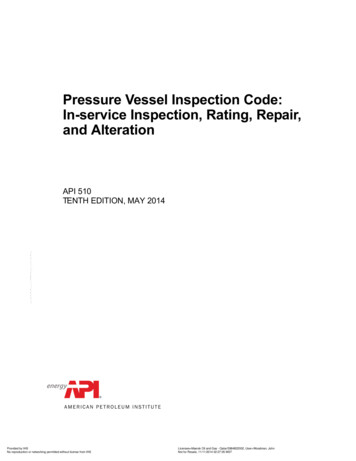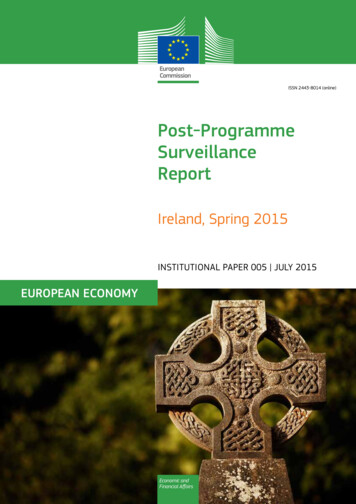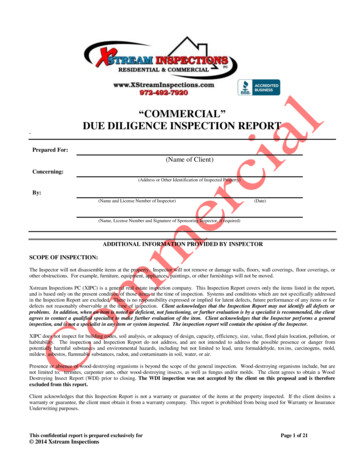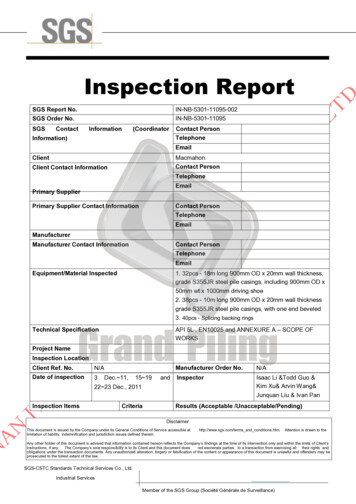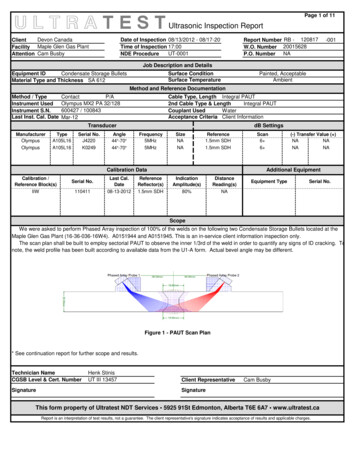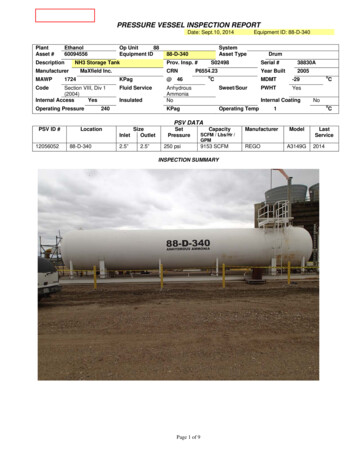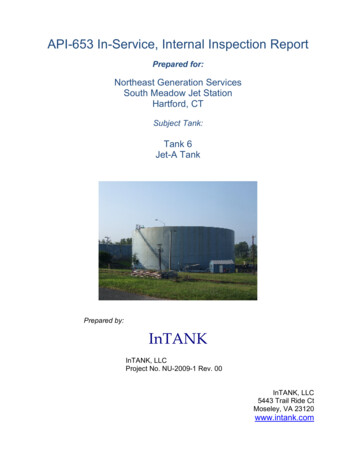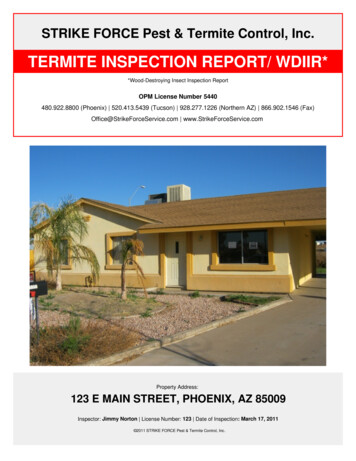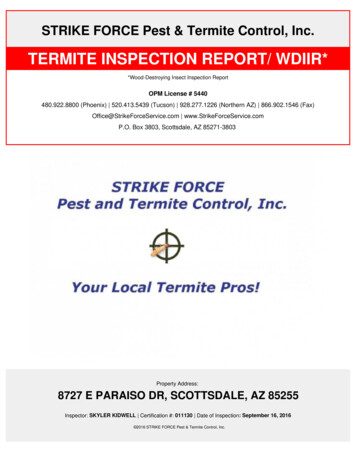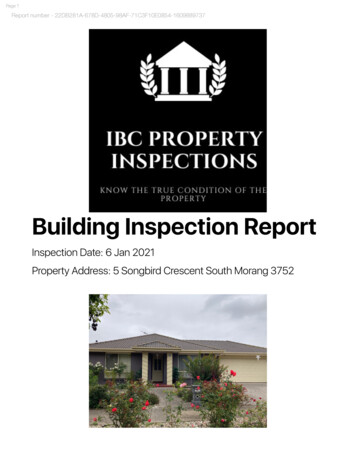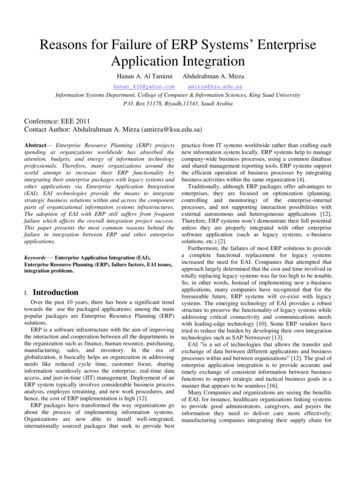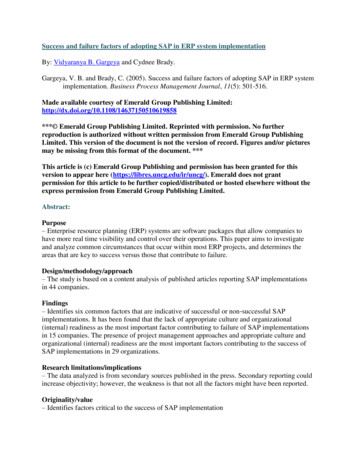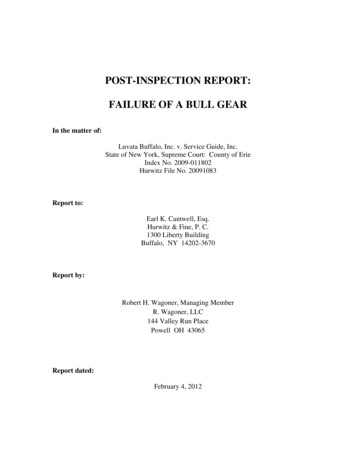
Transcription
POST-INSPECTION REPORT:FAILURE OF A BULL GEARIn the matter of:Luvata Buffalo, Inc. v. Service Guide, Inc.State of New York, Supreme Court: County of ErieIndex No. 2009-011802Hurwitz File No. 20091083Report to:Earl K. Cantwell, Esq.Hurwitz & Fine, P. C.1300 Liberty BuildingBuffalo, NY 14202-3670Report by:Robert H. Wagoner, Managing MemberR. Wagoner, LLC144 Valley Run PlacePowell OH 43065Report dated:February 4, 2012
R. H. WagonerFailure of Bull GearPage 2TABLE OF CONTENTSTITLE1TABLE OF CONTENTS2QUALIFICATIONS3CHRONOLOGY AND BACKGROUND4OPINION6BASIS OF OPINION 17BASIS OF OPINION 211LIST OF EXHIBITS15Exhibit A: Curriculum Vitae for Robert H. WagonerExhibit B: List of Materials Relied OnExhibit C: Inspection of Bull Gear on January 19, 2012, and SubsequentAnalysis on January 23, 2012
R. H. WagonerFailure of Bull GearPage 3QUALIFICATIONS1.I am Robert H. Wagoner, the George R. Smith Chair and Professor in theDepartment of Materials Science and Engineering, and the Department of MechanicalEngineering, at the Ohio State University. Along with my teaching responsibilities atOhio State, I supervise both masters and doctoral theses and conduct sponsored researchfor national and international companies and institutions. I also act as an independentmetallurgical and mechanical engineering consultant.2.I am a member of the National Academy of Engineering and am Fellow orequivalent of five professional engineering societies, as follows: AIME (AmericanInstitute of Mining, Metallurgical, and Petroleum Engineers), ASM International, ASME(American Society of Mechanical Engineers), SAE (Society of Automotive Engineers),and TMS (The Minerals, Metals, and Materials Society).3.I have been President of TMS and President of AIME. I have also servedas President of the TMS Foundation, Director of the Ohio State University ResearchFoundation, and Trustee for the Edward F. Orton Jr. Ceramics Foundation.4.A copy of my curriculum vitae appears as Exhibit A. My expertise relatedto this case includes: knowledge related to metallurgical engineering, mechanicalengineering, forming of metals and alloys, and mechanical and operative properties ofdevices constructed of various alloys.5.I am widely published in the field of materials science and engineering,and the field of mechanical engineering, including over 300 technical articles, 2proceedings volumes, 2 combined proceedings and authored books, and 2 textbooks. Thetopics of my publications include finite element analysis, micro-mechanisms of
R. H. WagonerFailure of Bull GearPage 4deformation, plasticity theory, material constitutive equations, and sheet metal forming.A list of publications and a partial list of invited and international presentations on thesetopics is included in Exhibit A.6.I am being compensated for my investigative and expert work in this caseat the rate of 300 per hour, and I am being reimbursed for out-of-pocket expenses Iincur.CHRONOLOGY AND BACKGROUND7.On December 7, 2010, I received a call from attorney Earl K. Cantwell ofHurwitz & Fine PC. The alleged “failure” or degradation of a large bull gear * wasdescribed briefly by Mr. Cantwell. My qualifications for investigating the causes of the“failure” were discussed. (For the remainder of this report, and in its title, I refer to thealleged failure or degradation of the bull gear as a “failure” for simplicity and brevity,without implying an opinion of the bull gear’s condition.)8.On December 23, 2010, I agreed to be retained by Hurwitz & Fine PC forforensic consulting and possible expert witness activities. The purposes of theseactivities were two-fold: 1) to determine, if possible, whether the bull gear was subjectedto the improper application of heat according to a theory proposed by Luvata and Lufkinemployees, and 2) to determine, if possible, how the gear failed.9.From December 23, 2010, to today, I received documentation that I haverelied on to analyze the bull gear failure. Those materials are listed in Exhibit B. I havereviewed this material at various times during that interval, particularly, but not*There have been at least three bull gears installed on the 44 Mill #2 Stand. Unless otherwise stated,references to the “bull gear” or “gear” in this report refer to the bull gear removed and reinstalled inDecember 2007.
R. H. WagonerFailure of Bull GearPage 5exclusively, during January 2010, June-July 2010, December 2010, and January 2011.10.The subject bull gear was a replacement ordered for the 44 Mill, Stand 2from the Philadelphia Gear Company on July 23, 1990. This order followed a serviceinspection report dated July 16, 1990, that noted that the pre-1990 bull gear had a ‘facerunout of the [pre-1990] main gear of 0.080,” ’ indicating that is was “bent or warped,”but otherwise showed little tooth wear (“light pitting on some teeth, (as noted) surfacefinish good, contact good, little wear”) †.11.The following information is stamped onto the surface of the subject bullgear that is the subject of the current action:PO 73536ORD 448097HT N0671VC 6984911-7-9012.The plaintiffs’ theory for the failure of the bull gear may be summarizedas follows: When Service Guide heated the subject bull gear to remove it from the shaft,they improperly, excessively and unevenly heated it at or near the rim, where the ringgear is installed. This heating was supposedly concentrated at an angular area identifiedby what plaintiffs call “heat witness marks” corresponding to black areas on the motorside ‡ face of the bull gear near the rim. Most of the remaining bull gear face presents anorangish/pinkish color characteristic of a paint or primer. (In his deposition, Mr. Wolfrefers to this as the “original paint color”.) In the plaintiffs theory, this paint or primer†Citations are to the Field Inspection Letter, Continental Machine and Engineering (C.M.E.) to AmericanBrass, July 16, 1990, including the drawing and inspection notes by C.M.E., July 5, 1990‡ There has been some confusion about the motor side and mill side of the subject bull gear. See myinspection report, Exhibit C, for a summary. I have adopted what I believe to be the correct labeling of thebull gear in this report.
R. H. WagonerFailure of Bull GearPage 6was burnt or transformed to a blackened state when the temperature reached a sufficientlyhigh temperature that was absent at other locations on the bull gear. The concentratedand uneven heating of the ring gear caused it to expand away from the hub, thuspermanently misaligning the ring gear with respect to the hub, producing unsatisfactoryrunout. The same region shows a break in a small weld used to retain a locating pinbetween the hub and ring gear of the bull gear, although this is on the other face of thegear.13.The sole indication supporting this theory is the apparent angularcorrelation of black regions near the rim on the motor side of the bull gear with the areaof maximum separation between the ring gear and hub.14.The evidentiary material provided by the plaintiffs is incomplete and muchof material provided is of poor quality. Among other items, many historical records ofthe subject bull gear and Mill 44 are missing, as are records for previous and subsequentbull gears installed on Mill 44. Engineering drawings and specifications, maintenanceand transport procedures, and other such records are absent. The photos provided are ofpoor quality, although it appears that electronic files are available (Luke Wolfdeposition). Runout measurements of the bull gear before removal for transport in 2007have not been provided. The bearings removed from the roto-pinion shaft in 2007 havenot been produced for inspection.15.In view of the absence of important evidence and the poor quality of otherevidence, I reserve the right to revise my analysis and opinion if and when additional orimproved-quality evidence is provided.16.On January 19 and January 20, 2012, I organized and carried out an
R. H. WagonerFailure of Bull GearPage 7inspection visit to Luvata Buffalo. On January 23, I carried out analytical scanningelectron microscopy (SEM) and energy dispersive spectroscopy (EDS) to determine thecomposition of the black areas on the subject bull gear. The results of the inspection andanalytical work appear as Exhibit C.OPINION17.OPINION 1: The bull gear was not subjected to improper, excessive, oruneven heating during its removal at Service Guide. The black regions are notindications of high temperature, and the black material is not burnt or transformed paint.18.OPINION 2: The most likely cause and sequence of failure wasidentified. The ring gear became deformed and the hub / ring gear interface wasweakened by cyclic fatigue in extended normal service. Aggravated by the weakenedstate, transport of the bull gear assembly without sufficient care deformed the ring gearwhere it rested on the minimally-padded floor of the transport truck.BASIS OF OPINION 119.To restate the plaintiff’s theory, with more precision: Service Guidepersonnel applied excessive heat near the ring gear portion of the bull gear over anangular region roughly between Load Pads E and A. (This same angular region canalternatively be described as including Holes 1 and 6, or being oriented between 225o and315o using Mr. Wolf’s arbitrary angular orientation. Figure 7 of the inspection reportshows the region as labeled the “Heat Zone” by Mr. Wolf in the LW drawing §.) Thisapplication of heat caused the ring gear to expand away from the hub to such an extent§The “LW drawing” refers to a drawing titled and marked as follows: 44 MILL 2 STAND BULL GEARFIELD MEASUREMENT / OBSERVATION RECORDING (Luke Wolf, 9-29-09)
R. H. WagonerFailure of Bull GearPage 8that it became permanently deformed and misaligned on the hub in this region.20.The plaintiffs’ theory rests on one point: the apparent matching of angularlocation of two features: 1) blackened areas on the motor side of the bull gear near or onthe ring gear, and 2) the area of maximum gap between the ring gear and hub (which isnear the area of the broken pin weld). The blackened areas on the bull gear (whichappear in many locations) are associated by the plaintiffs with the burning of paint suchas to leave a black residue that is visible today. These blackened areas are referred to as“heat witness marks” corresponding to what is called a “heat zone.”21.Many aspects of the evidence are contrary to the plaintiffs’ theory. Itwould take a high temperature differential between the ring gear and the hub to causeplastic deformation of the ring gear. It is very unlikely that permanent deformation as isnow observed could have occurred unless a large radial load on or a concentrated axialload on one angular position of the ring gear was applied, separately or concurrently withthe application of heat. Even if high heat were applied unevenly causing unevenexpansion, cooling would have brought ring gear and hub back into registry in theabsence of the application of a large external force. The locating pins would haveassured this. The magnitude of the force required can be understood by the fact that a400 ton press was found insufficient to remove the bull gear from the shaft even with theapplication of heat. The area of contact between shaft and bull gear is smaller thanbetween the ring hear and the hub.22.The plaintiffs’ theory is also contradicted by the appearance of the bullgear itself. First, unless a portion of the hub was exposed to a very high temperature (inexcess of approximately 400 deg. C, the range in which typical heat guns for paint
R. H. WagonerFailure of Bull GearPage 9removal operate), paint is unlikely to burn off. Such a high temperature would take along time to reach using gas burners. It would have been unnecessary to attain such atemperature for the removal of the shaft using a sufficiently large press. The originalpaint color (orange/pink depending on the light) appears to cover the majority of the bullgear surfaces on both sides, thus indicating that high temperatures were not reached overmost or all of the bull gear surface.23.It would normally be expected that black portions of the bull gearcorrespond to relatively cool regions during heating. This is consistent with the overallaspect of the bull gear in this case as well. Comparison of photographs of the bull gear atthe removal in 2007 show a coating of black sludge (although the current photos are quitepoor, this appears to be the case) on the surface of the bull gear that was mostly absentupon its return after heating for its removal from the shaft.24.Figure 1 of my inspection report shows a semi-circular pink areasurrounded by highly contrasting black area at approximately 4 o’clock as shown on thefigure. This configuration is reminiscent of how the soot from a candle deposits aroundthe hot flame region when held under a piece of metal. It appears that a gas torch waseither started while aimed at the center of that circle and then the gear was rotatedcounter-clockwise, or else that the torch was started elsewhere and the gear was rotatedclockwise until the torch came to a rest at the center of the orange/pink circle and thenwas shut off. The pink region thus corresponds to the hottest region during the operation(which would need to be well below the paint burn-off temperature), with the blackregions cooler.25.The maximum temperature reached at the center of the orange/pink
R. H. WagonerFailure of Bull GearPage 10circular area would have been well below the paint burn-off temperature. Thisinterpretation is consistent with what would be normally expected in terms of heating forremoval of the bull gear, i.e. the heat would be applied near the center of the spacebetween the central collar and the rim in order to maximize the temperature differentialbetween the collar and the shaft.26.With this interpretation in mind, at least two sources of the blackening canbe envisioned: 1) dirty oil left on bull gear after removal would have been baked on bythe
Analysis on January 23, 2012 . R. H. Wagoner Failure of Bull Gear Page 3 . QUALIFICATIONS . 1. I am Robert H. Wagoner, the George R. Smith Chair and Professor in the Department of Materials Science and Engineering, and the Department of Mechanical Engineering, at the Ohio State University. Along with my teaching responsibilities at Ohio State, I supervise both masters and doctoral theses
